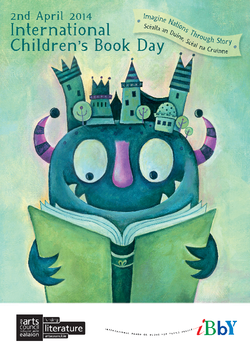2014 Ireland
Letter to the children of the world
Readers often ask writers how it is that they write their stories – where do the ideas come from? From my imagination, the writer answers. Ah, yes, readers might say. But where is your imagination, and what is it made of, and has everyone got one?
Well, says the writer, it is in my head, of course, and it is made of pictures and words and memories and traces of other stories and words and fragments of things and melodies and thoughts and faces and monsters and shapes and words and movements and words and waves and arabesques and landscapes and words and perfumes and feelings and colours and rhymes and little clicks and whooshes and tastes and bursts of energy and riddles and breezes and words. And it is all swirling around in there and singing and kaleidoscoping and floating and sitting and thinking and scratching its head.
Of course everyone has an imagination: otherwise we wouldn't be able to dream. Not everyone’s imagination has the same stuff in it, though. Cooks’ imaginations probably have mostly taste in them, and artists’ imaginations mostly colours and shapes. Writers’ imaginations, though, are mostly full of words.
And for readers of and listeners to stories, their imaginations run on words too. The writer’s imagination works and spins and shapes ideas and sounds and voices and characters and events into a story, and the story is made of nothing but words, battalions of squiggles marching across the pages. Then along comes a reader and the squiggles come to life. They stay on the page, they still look like battalions, but they are also romping about in the reader’s imagination, and the reader is now shaping and spinning the words so that the story runs now inside his or her head, as it once did in the head of the writer.
That is why the reader is just as important to the story as the writer. There is only one writer for each story, but there are hundreds or thousands or maybe even millions of readers, in the writer’s own language, or perhaps even translated into many languages. Without the writer the story would never be born; but without all the thousands of readers around the world, the story would not get to live all the lives it can live.
Every reader of a story has something in common with every other reader of that story. Separately, and yet in a way also together, they have re-created the writer’s story in their own imagination: an act that is both private and public, individual and communal, intimate and international. It may well be what humans do best.
Keep reading!
Written by Siobhán Parkinsona, author, editor, translator and former Laureate na nÓg (Children’s Laureate of Ireland)
Poster illustrated by Niamh Sharkey
Download the poster here


